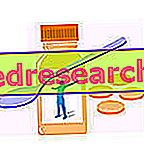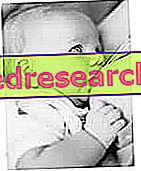Generality
Tourette syndrome is a disorder that causes multiple and involuntary motor and phonic tics. It arises during childhood, or adolescence, and affects the social and educational life of young patients.
Tics are often not the only symptoms, as they are associated with other neuropsychiatric disorders.

What is Tourette syndrome
Tourette syndrome is a neuropsychiatric disorder of childhood and adolescence, characterized by motor and phonic (or vocal ) tics . These tics consist of repeated and involuntary movements and sounds; they are, moreover, difficult to control and unmotivated, that is, lacking a precise purpose.
ASSOCIATED DISORDERS
Often, young patients may show attention deficit, hyperactivity and other behavioral disorders . These associations further worsen the clinical picture.
TIC IN TOURETTE SYNDROME
Repetitive tics are very common in childhood and adolescence. Often, however, these tics are NOT linked to certain neuropsychiatric pathologies. These involuntary manifestations last less than a year and are fluctuating: that is, they come and go.
Tourette syndrome, on the other hand, is characterized by exhausting tics, repeated many times during the day and long stay (over a year).
ADULTHOOD
In most cases, with the achievement of adulthood, the tics disappear or diminish considerably. After adolescence, few people continue to present, with the same frequency, typical disorders of Tourette syndrome.
Epidemiology
Tourette syndrome is quite common. It affects about one in 100 people and is three times more common in males than in females.
Causes
The precise cause of Tourette's syndrome is unknown. However, several hypotheses have been made about the origin of the disease:
- Genetic theory
- Neurological theory
- Environmental theory
GENETIC THEORY
This theory is based on the observation that, very often, young patients with Tourette syndrome have at least one family member (father, mother or brother) with the same disorders. This suggests that there may be a gene, or more than one, involved in the onset of the disease. At the moment, there are no clues as to what this gene is and how it is transmitted between parents and children.
NEUROLOGICAL THEORY
Some studies claim that there are brain deficits behind Tourette syndrome. These dysfunctions concern dopamine and the dopaminergic system : it seems, in fact, that the limbic areas, the basal ganglia and the pre-frontal cortex, present in the brain, are involved.
NB: dopamine is a neurotransmitter produced in the brain. It has many functions: for example, it acts on behavior, voluntary movement, sleep, mood, motivation and learning.
ENVIRONMENTAL THEORY
There is no definite evidence to confirm this theory. However, it has been shown that there is a relationship between Tourette's syndrome and a problematic pregnancy .
| Problems, during pregnancy, at the origin of Tourette's syndrome |
|
Another environmental factor, still under study, is strep infection .
Symptoms and associations
To learn more: Symptoms Tourette syndrome
The characteristic symptoms of Tourette syndrome are motor tics and phonic ( or vocal) tics .
On the other hand, less common manifestations are coprolalia, palilalia, some socially inappropriate behaviors, echolalia and ecoprassia .
Finally, as mentioned, Tourette syndrome is often accompanied by behavioral disorders, such as:
- Attention deficit hyperactivity disorder (ADHD, in English; DDAI, in Italian)
- Obsessive-compulsive disorder (DOC)
- Learning difficulties
- Self-harm
- Mood changes
TIC MOTORS AND TONE PHONICS
- Motor tics are involuntary movements performed without a purpose.
The phonic tics consist of the uncontrolled emission of meaningless sounds.
They are manifestations that certainly do not go unnoticed: in fact, they are repeated in a grueling way and afflict a patient for a period of time over a year. Sometimes, they are so intense that they complicate social relations and school activity.
From patient descriptions, tic is a necessity, comparable to a sneeze or scratching for an itch; the execution is felt as the release from an accumulation of tension.
The tics can appear when the patient is between 2 and 14 years of age, although, generally, they arise at the age of 7-8 years.
| Tic engines | Phonic (or vocal) tics |
| Blinking of the eyelid (s) | Throat clearing |
| Head shaking | To cough |
| Mouth twist | Sniff |
| Contraction of the mouth | Shouting |
| Extension of the limbs (for example, kicking) | Imitate animal sounds |
| Shoulder shots |
OTHER SYMPTOMS
Premise: some medical texts consider coprolalia, palilalia, ecolalia and ecoprassia as complex phonic / motor tics.
Coprolalia is the patient's continuous utterance of obscene and vulgar words / phrases.
Sometimes, the patient performs only in rude, but not obscene behavior. In this case, we talk about non-obscene socially inappropriate behavior (NOSI).
Coprolalia and NOSI are spontaneous acts, which should not be confused with the patient's lack of education or morality. Often, Tourette syndrome is identified with these two symptoms, but it is right to specify that they are rare manifestations, which occur only in 10-15% of patients.
The palilalia is the repetition of some of its own words, without any reason and out of place.
Ecolalia and ecoprassia are, respectively, the repetition of words spoken by others and the repetition of gestures made by others. Again, these are unjustified acts.
DISORDERS ASSOCIATED WITH TOURETTE SYNDROME
Patients with Tourette syndrome may have other associated neuropsychiatric disorders . In medical language, the condition that a person shows two symptoms of different origins is called comorbidity .
There is no certain data concerning the frequency of these morbid associations: some studies report that 8-9 cases out of 10 manifest other pathologies, in addition to tics; other studies, on the other hand, speak of a lower frequency, around 4-5 out of 10 cases.
The most important and serious associated diseases are:
- Attention deficit hyperactivity disorder ( ADHD or ADHD )
- Obsessive-compulsive disorder ( DOC )
Instead, they are less common:
- Learning difficulties
- Self-harm
- Mood changes
Comorbidity worsens the insertion of the young patient in the social and scholastic context.
The following table summarizes the main features of the different diseases associated with Tourette syndrome.
| Associated pathology | Short description |
| ADHD or ADHD, attention deficit hyperactivity disorder | Patients are easily distracted, careless and disorganized. They play and speak loudly. They are always on the move and interrupt the activities of the people around them |
| DOC, obsessive-compulsive disorder | Anxiety and loss of control, due to the fear of making inappropriate gestures or uttering vulgar words. Obsessions are repetitive, aimless actions: for example, repeated washing of hands or counting of objects |
| Learning difficulties | It manifests as dyslexia and dysorthography |
| Self-harm | Tendency to bite, scratch, hit the head or punch |
| Mood changes | Anxiety and depression |
Diagnosis
Premise: there is no test or instrumental examination that allows the diagnosis of Tourette's syndrome. Therefore, doctors rely on meticulous observation of symptoms and a text, the so-called " Diagnostic and Statistical Manual of Mental Disorders " (in English DSM) fourth edition. It gives an accurate description of the symptoms of mental illnesses. His consultation is a tool for comparison, to which one can rely when one encounters a suspected case of Tourette's syndrome.
SOME HINGE POINTS OF THE MANUAL
Below are some basic steps in the DSM Manual, which help in the diagnosis.
This is Tourette's syndrome, if:
- The patient shows multiple motor tics and one, or more, phonic tics
- Engine and sound tics last at least a year
- The frequency of tics, within the same day, is high
- The remission from the tics does not go beyond the three consecutive months
- The disorders arise before the age of 18
- The onset should not be due to taking a substance (drug or drug)
DIFFERENTIAL DIAGNOSIS
Tics can be caused or confused with other different morbid conditions. For example:
- Epilepsy
- Brain abnormalities
- Hypothyroidism
- Drugs (cocaine)
- Wilson disease
- Autism
- Encephalitis (Sydenham Korea)
- Huntington's Korea
- Klinefelter syndrome
- drugs
- Tuberous sclerosis
Therefore, it is true that there is no diagnostic test for Tourette syndrome, but undergoing instrumental tests may be useful to rule out some of the aforementioned diseases.
The recommended tests are: an electroencephalogram, a brain MRI and a urine test.
NB: the motor tonic, or phonic, represents only one of the symptoms of the illnesses present in the list. In fact, each of them presents itself with other, sometimes unequivocal, manifestations.
Therapy
Two premises:
- Most patients with Tourette syndrome have a mild form of the disease that does not require special treatment.
- In adulthood, as already mentioned, spontaneous remission of the disease occurs, sometimes without consequences.
As for the diagnosis, there is no specific therapy for Tourette syndrome. However, it is possible to alleviate symptoms by administering drugs and psychological and behavioral care . These therapeutic interventions improve the quality of life of young patients, particularly when they are afflicted with severe forms of the disease.
If these treatments are unsuccessful, surgery can also be used, but this is a little considered option, as it is uncertain and very dangerous.
PHARMACOLOGICAL THERAPY
The purpose is twofold:- Reduce the frequency of tics
- Contain attention deficit disorder and obsessive-compulsive disorder
To reduce tics and some obsessive behaviors, antipsychotics are given to the patient. Antipsychotics modulate some brain messengers, neurotransmitters, such as dopamine, noradrenaline and serotonin. They can have partial success and serious side effects.
To act on anxiety due to obsessive-compulsive disorders, a benzodiazepine is used: clonazepam . The administration does not always have the desired effects.
Finally, stimulants such as methylphenidate are used to stem attention deficits.
The table shows the most used drugs in cases of Tourette's syndrome.
| Antipsychotics | Purpose |
| Haloperidol Risperidone Pimozide Aripiprazole sulpiride | Reduce the frequency of tics and some obsessive behaviors |
| benzodiazepines | Purpose |
| Clonazepam | Antidepressant, sedative and anxiolytic |
| Stimulants of attention | Purpose |
| methylphenidate | Contain attention deficits due to ADHD (or ADHD) |
NB: at the moment, these drugs are not registered for the treatment of Tourette's syndrome, due to side effects and uncertain success. Some are indicated for associated pathologies, as in the case of methylphenidate, but, also in this case, there are conditions of use.
PSYCHOLOGICAL AND BEHAVIORAL THERAPY
The main psychological therapies are cognitive-behavioral psychotherapy ( TCC ) and the so-called Habit Reversal Training .
The purpose is to reduce the frequency of tics, teaching the patient to master the need to perform them. Being able to control tics is of enormous help to improve inclusion in the social and school environment. Unfortunately, these two psychotherapies are not always successful.
EDUCATION AND SUPPORT
Family members of Tourette's sufferers play a key role during the therapeutic course. In fact, we have seen that treatments are more effective in those patients who are supported by families. It is therefore essential that parents document the appropriate behavior to adopt in these cases and then put it into practice.
Another important role is played by the school. It must promote the inclusion of individuals with Tourette syndrome. Teachers must support a patient, understand their problems and make them feel accepted by other students. A "hostile" school environment contrasts with the efforts made by families, making recovery more difficult.
SURGERY
This is called deep brain stimulation ( Deep Brain Stimulation, DBS ). The surgical procedure involves the insertion of electrodes in the brain. These electrodes stimulate those brain areas that are suspected to be involved in Tourette's syndrome.
It is a method still being perfected, as it is not without complications. At the moment, it is only implemented when drugs and psychotherapy do not work.
Prognosis
The prognosis, for those with Tourette's syndrome, is different on a case-by-case basis. Furthermore, there are no clinical examinations for which it is expected to evolve.
In most patients, when they reach adulthood, a spontaneous and almost complete remission of the disease occurs. The prognosis is positive, as tics become rare episodes; consequently, they do not affect the quality of life of patients.
However, a small percentage of cases manifest, even in adulthood, frequent tics and other obsessive disorders. For these people, social and work life can be affected: getting accepted and carrying out a certain activity can become very difficult. Therefore, the prognosis is less good than the previous one.
It should, however, be remembered that, whatever the pathological course, the intelligence and life span of Tourette's patients do not suffer repercussions.



